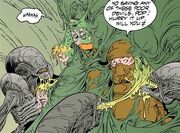
Hive resin,[1] also referred to as Hive webbing[2] or Hive space,[3] is the name given to the substance used by Xenomorphs to construct their Hives and to cocoon potential hosts within. The material is excreted from the creature's jaws,[2] particularly by Drone and Worker castes.
Composition and Purpose
Much like the silk spun by terrestrial spiders, Hive resin is a proteinaceous substance that hardens upon drying.[2] However, unlike Earth-based insect silk, it is hydrocarbon-based.[1] It is excreted (often liberally) from the jaws of Xenomorphs as a clear, saliva-like fluid and hardens rapidly, allowing the creatures to construct Hives and cocoon potential hosts in a relatively short period of time.[1] In its hardened state, it adopts a darker, translucent color, often varying shades of black, brown and/or green. Once hardened, the resin is relatively elastic whilst still retaining exceptional tensile strength.[2]

The primary purpose of the resin is seemingly twofold — as well as being used to cocoon and immobilize captured hosts for implantation via Facehugger, its non-uniform, bio-organic appearance also allows adult Xenomorphs to camouflage themselves when at rest, to the extent that humans have stood directly beside hiding Drones and had no idea of the imminent threat.[4] In the case of Hives set up inside existing non-Xenomorph structures, the resin helps to disguise existing visual cues in the environment, turning the area into a disorientating maze and making escape from and/or assaults on the Hive all the more difficult. However, whether this is considered by the Xenomorphs during construction is unclear. The structure of a Hive also appears to have a disrupting effect on motion tracker operation, generating a host of false readings that imply the entire area is awash with sporadic movement, making genuine readings harder to spot.[4][5] The exact cause of this is unclear. The resin itself is also resistant to the effects of the Xenomorph's acidic blood.[6]
It is theorized that the resin may play a role in providing the Xenomorphs of a Hive with vital nutrients, by leeching them from the surrounding environment — be it soil or even metal — and packaging them into forms easily absorbed by the creatures.[3] Given that Xenomorph Hives are almost always found to be hot and humid in nature, it is also possible that the resin possesses some ability to modify atmosphere, at least locally, to better suit the needs of the nest. However, no confirmed evidence of such a process has ever been collected.
See Also
- Hive Node — An organism secreted by Drones in the video game Aliens versus Predator: Extinction that generates hive resin.
References
- ↑ 1.0 1.1 1.2 Weyland-Yutani Archives (2008), 20th Century Fox [Blu-ray]
- ↑ 2.0 2.1 2.2 2.3 S. D. Perry. Alien: The Weyland-Yutani Report, p. 21 (2014), Insight Editions.
- ↑ 3.0 3.1 Aliens versus Predator: Extinction, EA Games, 2003.
- ↑ 4.0 4.1 James Cameron (writer and director). Aliens (1986), 20th Century Fox [DVD].
- ↑ Alien: Isolation, Microsoft Windows, PlayStation 3, PlayStation 4, Xbox 360, Xbox One version, Creative Assembly, 2014.
- ↑ Cite error: Invalid
<ref>tag; no text was provided for refs namedAFT